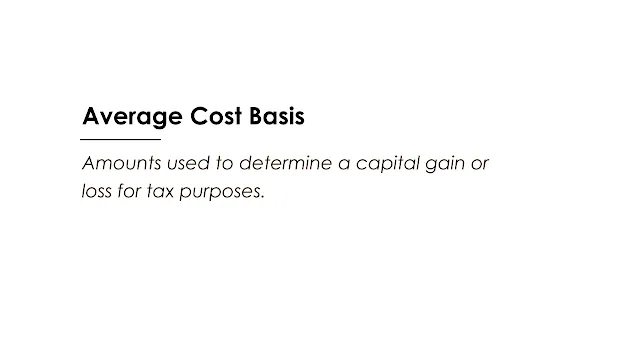
|
| Image: Moneybestpal.com |
Identifying the cost basis of one's holdings can be difficult for investors when they acquire and sell mutual fund shares. Amounts used to determine a capital gain or loss for tax purposes are called cost basis, which is an investment's beginning worth.
The difference between the selling price and cost basis of the shares is the capital gain or loss. Depending on how they acquired the shares and how they reported them to the IRS, investors can choose from a variety of approaches to determine the cost basis of their mutual fund holdings.
The average cost basis approach, one of the most popular ones, takes into account the complete price paid for the shares, including any dividends, capital gains distributions, or capital returns that were reinvested.
How to Calculate the Average Cost Basis
Advantages and Disadvantages of the Average Cost Basis Method
The average cost basis method has some advantages and disadvantages for investors. Some of the advantages are:- Calculation and application are simple.
- It is not necessary to keep track of the price or purchase date of every share.
- Investors who often buy and sell shares benefit from less paperwork.
- If the investor sells shares that have appreciated more than average, the taxes may be reduced.
- Investors cannot pick and choose which shares to sell to minimize their tax obligations.
- If the investor sells shares that have appreciated less than average, it might lead to greater taxes.
- It might not accurately reflect how each share in the account has performed in practice.
Alternatives to the Average Cost Basis Method
The average cost basis method is not the only option for investors who want to calculate their cost basis for mutual fund positions. The IRS also allows other methods, such as:First-in first-out (FIFO):
According to this approach, the investor will sell the oldest shares first. If a shareholder sells shares that have been held for more than a year and are eligible for long-term capital gains rates, the taxes owed may be reduced.
Last-in first-out (LIFO):
This approach presupposes that the investor sells the most recent shares first. If the investor sells shares that have lost value since being bought, it might result in lower taxes.
Specific identification:
Using the purchase date and price as a guide, the investor can select which shares to sell using this strategy. If the investor sells shares with a greater cost basis than other shares, it can result in reduced taxes.
Before selecting a strategy, investors should speak with their tax consultants as each has advantages and disadvantages. Investors must also keep accurate records of their transactions and disclose their chosen technique to their brokerage firms.
